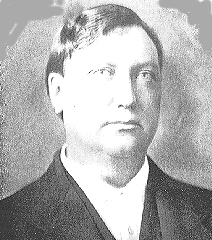Frank Steunenberg, former governor of Idaho, was returning through eight inches of freshly fallen snow to his home in Caldwell, Idaho shortly after six p.m. on December 30, 1905 when he pulled a wooden slide that opened the gate to his side door, triggering a bomb that blew him ten feet into the air. Within an hour, he was dead. Steunenberg's assassination was to lead to one of the most remarkable trials in American history.
Steunenberg was born in Iowa in 1861. After leaving school at age 16, he apprenticed for Knoxville, Iowa paper for four years before taking a job as a typefitter for the Des Moines Register. Steunenberg quit his job in Des Moines, studied two years at the Iowa Agricultural College in Ames, then returned to Knoxville where he published the local paper until 1886. Steunenberg arrived in Idaho in 1887 after receiving a request to help a brother who had just acquired the moribund Caldwell Tribune. Steunenberg began writing stories on topics of local interest, especially the town's dire shortage of unmarried females.
Steunenberg was elected to the state legislature in 1890, and ran as one of five candidates for the Democratic nomination for governor in 1896. Politics were in disarray in Idaho in 1896. The Idaho Republican Party was split between those loyal to the national ticket headed by William McKinley, a champion of keeping the gold standard, and Silver Republicans who favored a move to a silver standard that would greatly benefit Idaho's many silver mines. Steunenberg won the Democratic nomination by endorsing "fusion" with the Populist ticket, then went on to win the governorship by the biggest landslide in Idaho's history.
When labor violence erupted in northern Idaho in 1899, Governor Steunenberg took a tough stance. He said at the time, "We have taken the monster by the throat and we are going to choke the life out of it. No halfway measures will be adopted. It is a plain case of the state or the union winning, and we do not propose that the state shall be defeated." Steunenberg declared martial law and asked President McKinley to send federal troops, a decision which led to the arrests of hundreds of union activists who were rounded up and kept in northern Idaho stockades for months without trials. Steunenberg's assassination was retaliation for these strong anti-union measures.

